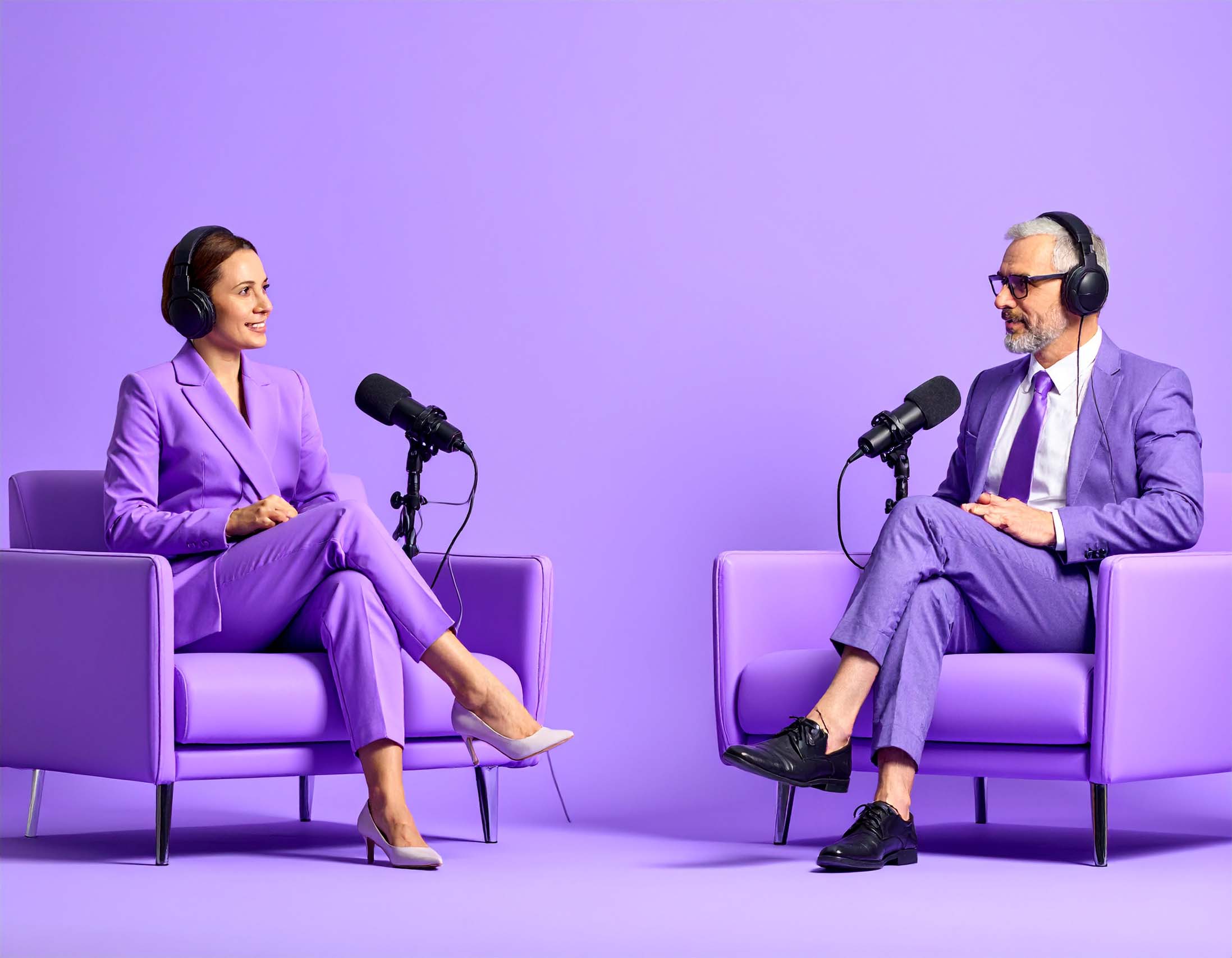

The podcast format you choose influences the way audiences connect with your content, the workload you carry, and the long-term perception of your brand.
At Macromise, we guide leaders and brands in selecting the right podcast structure and production model so that the content not only resonates with their audience but also aligns with their long-term goals. Below we explore the common podcast formats available, their advantages and challenges, and the production considerations that shape them.
The solo or monologue format places a single host at the centre of the talk, sharing insights, commentary, or storytelling without a guest. This format is particularly effective for leaders or professionals who have a wealth of subject-matter expertise and want to build a strong voice of authority.
The main benefit is the control it gives the host. Content, tone, and style are entirely in their hands. Additionally, this format avoids the complexities of scheduling guest appearances. For those committed to consistency, setting up a home or office studio is often the best approach which makes this format cost-effective.
On the downside, however, this format does not offer the networking benefits that other formats provide. Additionally, it requires investing considerable effort in planning and scripting to keep episodes engaging.
The interview format is one of the most popular podcast structures, where a host speaks with a guest, often an expert, leader, or innovator. This format is particularly suited for busy executives who want to expand their networks and influence without building a complex content plan. Each episode brings fresh perspectives through the guest’s experience while giving the host the opportunity to showcase their own expertise through their comments and smart, well-prepared questions.
Production can take place either online or in a studio. Online interviews are flexible and cost-effective, enabling global access to guests without geographical limits. However, this approach sometimes means dealing with varied sound and video quality, depending on the guest’s setup. Studio recording, on the other hand, allows for better control over quality and offers a sense of prestige, but it requires greater investment and limits guest selection to those who can travel or are based locally. The interview format is a natural choice for leaders aiming to build influence while benefiting from the networks of their guests.
In the co-hosted format, two or more regular hosts share the microphone. It is often a strong choice for co-founders who want to showcase their partnership or professionals who bring different but complementary expertise to the table.
This format is often lighter and more approachable, and it distributes the responsibility of content creation across hosts. It can be recorded remotely with each host in their own location, or in studio settings where rapport is easier to capture. The main challenge lies in maintaining focus. Without clear roles or planning, conversations can drift, leading to episodes that feel unfocused. When done well, however, co-hosted shows are a powerful way to showcase collaboration, thought diversity, and human connection behind a brand.
The roundtable format brings multiple voices together to discuss a single topic, guided by a host or moderator. This structure works well in industries where multi-perspective insights matter, such as healthcare policy, finance regulation, or engineering innovation. By bringing different leaders into one conversation, a brand can establish itself as a convener of ideas and a hub for industry dialogue.
The strength of this format lies in the richness of perspectives and the networking opportunities it creates. Each guest can help promote the episode to their own networks, multiplying reach and influence. Yet it comes with logistical challenges, particularly when aligning schedules for several senior figures.
To ensure clarity, it is also important to keep panels small, typically no more than three participants for an episode under one hour. Recording can be done remotely, but for maximum impact, hosting panel sessions in a studio or live event environment can help capture both quality and atmosphere.
Narrative podcasts are structured around storytelling, often weaving together narration, interviews, and sound design to create a rich, immersive experience. This style is particularly effective for brands aiming to highlight impact stories, communicate mission, or raise awareness about complex issues.
The advantages of narrative formats lie in their emotional connection and high memorability. They stand apart from traditional talk formats and can elevate a brand’s image significantly. However, they are also resource-intensive, requiring research, scriptwriting, professional editing, and strong sound design. Without attention to detail in production, the immersive quality that defines this format can fall flat. For organisations willing to invest, narrative podcasts can be a powerful form of branded storytelling that resonates long after the episode ends.
Hybrid podcasts blend two or more styles. A host may begin with solo reflections, move into a guest interview, and close with a summary or call to action. This structure offers variety and allows leaders to combine thought leadership with external perspectives. It is especially effective for founders who want to build their own voice while also leveraging guest expertise.
The challenge lies in execution. Hybrid shows demand careful planning to avoid feeling disjointed, and they often require more production time. When well-structured, however, they bring the best of both worlds, positioning the host as both an authority and a connector.
Micro-episodes are short recordings (typically five to ten minutes) that deliver a single insight, tip, or update. These are ideal for busy audiences who prefer digestible content and for industries where rapid updates are valuable, such as health or finance.
This format is relatively easy to produce and cost-efficient, especially when episodes are batch recorded. It also allows for frequent audience touchpoints, keeping a brand consistently in front of listeners. However, brevity limits depth, and producing high-value insights in such a short time requires clarity and strong content planning.
Live podcasting involves recording episodes in front of an audience, either at events, conferences, or through live streams. These shows bring energy and immediacy, creating memorable experiences for listeners and participants alike. For leaders and brands, they can double as marketing events and community-building opportunities.
Live podcasting offers deeper engagement, a strong brand statement and a sense of exclusivity around the content. However, they require careful technical preparation: the unpredictability of live events means the margin for error is slim.

Here are key questions a leader or brand should ask when picking a format. Macromise helps guide clients through this decision process:
Factor | Questions to Ask |
Goal / Purpose | Are you building personal authority? Educating? Entertaining? Marketing a product/service? |
Audience Preference | Do they prefer stories, news, deep technical discussion, or inspiration? What is the time available? |
Resources | Time, budget, production capability, guest network, scripting / editing support. |
Brand Voice / Personality | How formal/informal? How polished? How much flexibility or spontaneity? |
Distribution & Reach Priorities | Guest-driven reach? High-quality video/audio for visuals? Live events? Social media clips? |
Once you choose a format, your production model should match. Here are some options:
The choice of podcast format shapes how audiences perceive you, how easily the show can be sustained, and how much influence it can generate over time. Solo podcasts can cement authority, interviews can expand networks, narratives can elevate brand stories, and live shows offer more audience engagement.
For leaders and brands, the key is to balance ambition with practicality. With the right format and the right production model, a podcast can become a powerful platform for influence and connection. At Macromise, we help clients make that choice and support them through every step of the process, from concept to consistent impact.
Our team helps evaluate which formats align best with audience expectations and business goals, and we often pilot episodes to test approaches with minimal risk. Beyond strategy, we provide full production support. For leaders seeking more ambitious formats, such as hybrid or narrative storytelling, we bring the creative and technical expertise needed to deliver them with polish. Ultimately, our role is to make podcasting easy for you while amplifying your voice and maximising your brand impact.